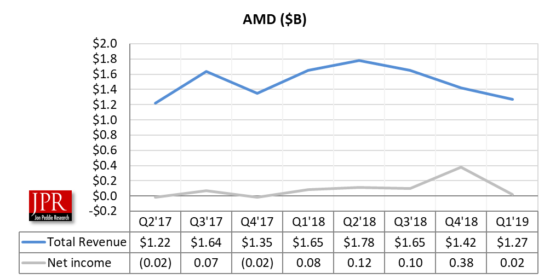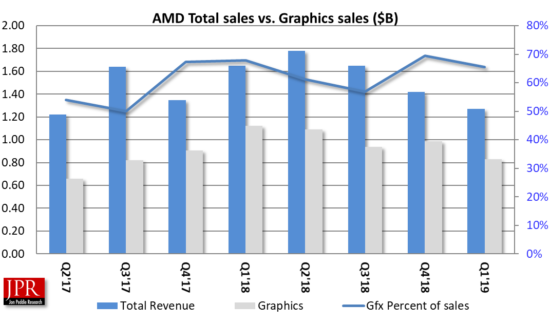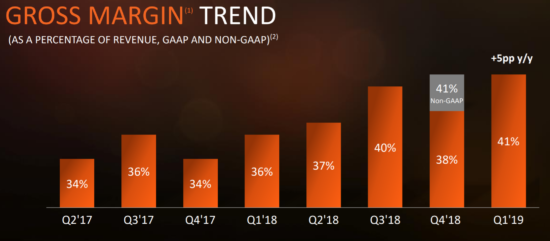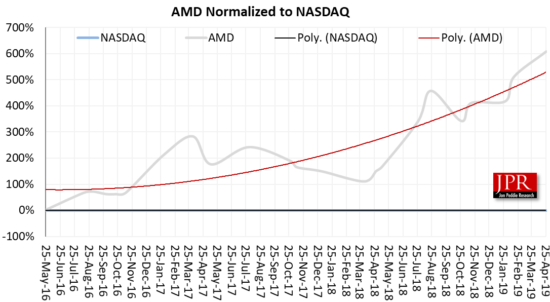Revenue for the quarter was down -10.5% from last quarter to $1.3 billion, GAAP profit was $20 million, down -23% from last quarter.
 AMD reported its quarterly results for calendar Q1 2019; revenues and operating income were down year-over-year as well as its graphics and compute groups revenue and profits.
AMD reported its quarterly results for calendar Q1 2019; revenues and operating income were down year-over-year as well as its graphics and compute groups revenue and profits.
“We delivered solid first quarter results with significant gross margin expansion as Ryzen and EPYC processor and datacenter GPU revenue more than doubled year-over-year,” said Dr. Lisa Su, AMD president and CEO. “We look forward to the upcoming launches of our next-generation 7-nm PC, gaming and datacenter products which we expect to drive further market share gains and financial growth.”
Revenue was $1.27 billion, down 23% year-over-year primarily due to lower revenue in the Computing and Graphics segment. Revenue was down 10% quarter-over-quarter primarily due to lower client processor sales.
Gross margin was 41%, up 5 percentage points year-over-year, primarily driven by the ramp of Ryzen and EPYC processor and datacenter GPU sales. Gross margin was up 3 percentage points quarter-over-quarter primarily due to a charge in the fourth quarter of 2018 related to older technology licenses. Operating income was $38 million compared to operating income of $120 million a year ago and $28 million in the prior quarter. The year-over-year decline was primarily due to lower revenue and operating income in the Computing and Graphics segment. Net income was $16 million compared to net income of $81 million a year ago and $38 million in the prior quarter.

R&D expenses were $371 million (29% of revenue), up $3 million Y/Y, and $2 million Q/Q. MG&A expenses were $170 million (13% of revenue), up $37 million Y/Y and $32 million Q/Q.
Graphics group
Computing and Graphics segment revenue was $831 million, 26% Y/Y and down 16% Q/Q. The Y/Y and Q/Q decrease was primarily due to lower client processor sales.
Client processor average selling price (ASP) was up year-over-year driven by Ryzen processor sales. Client ASP was down slightly quarter-over-quarter due to a decrease in mobile processor ASP. GPU ASP increased year-over-year primarily driven by datacenter GPU sales. GPU ASP was up sequentially driven by an improved product mix.
Operating income was $68 million, compared to operating income of $14 million a year ago and an operating loss of $6 million in the prior quarter. The year-over-year and sequential improvements were primarily driven by a $60 million licensing gain associated with the company’s joint venture with THATIC. All Other operating loss was $46 million compared with operating losses of $32 million a year ago and $81 million in the prior quarter. The prior quarter included a $45 million charge related to older technology licenses.

The company announced the new AMD Ryzen Embedded R1000 SoC, growing the AMD Ryzen embedded family of processors. The SoC will be used in numerous embedded applications from customers like Advantech, IBASE, ASRock, Kontron, MEN, and others. It will also power the upcoming Atari VCS entertainment system.

Multiple customers began shipping new 2nd Gen AMD Ryzen mobile-powered laptops, including the new ASUS FX505 and 705DY TUF gaming notebooks, with additional systems coming throughout 2019.
Outlook
For the second quarter of 2019, AMD expects revenue to be approximately $1.52 billion, plus or minus $50 million, an increase of approximately 19% sequentially and a decrease of approximately 13% year-over-year. The sequential increase is expected to be driven by growth across all businesses. The year-over-year decrease is expected to be primarily driven by lower graphics channel sales, negligible blockchain-related GPU revenue, and lower semi-custom revenue.
What do we think?
AMD celebrated its 50th anniversary on May 1st, 2019.

For the quarter, AMD revenues of $1.27 billion were down 23% over the prior year period, but that was better than the estimates by Wall Street, so the share price saw a nice bump. The drop in sales was expected given the decline in late 2017 and early 2018 of the cryptocurrency boom, plus weakness in China which is hurting the overall sector.
The computing and graphics segment was the primary loser, seeing its revenues drop 25.5%, while the smaller Enterprise, Embedded, and Semi-Custom segment saw a decline of 17.1%.
AMD also announced their involvement with Oak Ridge for the new Frontier XFLOPS super computer that will be operational the summer of 2021.

AMD’s share price is up 50% this year because of a strong pipeline of new products. The latest earnings report suggests that the company’s 2019 plans are on track.





